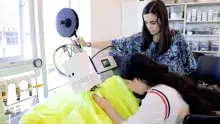
A unique hyperbaric chamber to aid mountaineers suffering from altitude sickness has won Kwantlen Polytechnic University students an award from an industry-leading website.
They won the student project category in the Commercial Equipment Design Award at the Core77 Design Awards.
“It feels absolutely amazing to have our project recognized because of the immense amount of energy and work that went into it,” says project coordinator Camille Dansereau, a student in the Wilson School of Design at KPU. “We were on campus every day until closing, constantly researching, testing, iterating, evaluating and reevaluating to make sure we came up with the best solution possible.”
The hyperbaric chamber they designed can be used in high-altitude situations to simulate bringing the climber down to a lower altitude while they are still on the mountain. The project was completed over nine weeks by 10 third-year product design students.
“The project encompassed extensive research, expert interviews, ideation, prototyping, and testing as well as the production of a final working prototype,” says student project leader Clarissa Martins.
Sue Fairburn, product design instructor at the Wilson School of Design at KPU says the project was probably 50 per cent research with students learning from experts while prototyping their final concept.
“They started broad and research the context of increased recreational climbers, altitude-related illnesses and they took on board a lot of complex human science and the physics of pressure,” says Fairburn. “They did deep market research and they learned from experts - about the body, about materials and technologies used to work with pressure and about the reality of being in the field and experiencing the effects of altitude firsthand from young climbers who'd recently completed the seven summits [of the highest peaks on each continent].”
“This award is about the recognition that the judges in the design community can see the value of hands-on design and prototyping leading to full-scale prototypes for real-world challenges - this approach is central to what we do at the Wilson School of Design. Core77 is highly regarded for recognizing design achievements where they matter - addressing challenges in society, in climate change, and applying design to mobilize solutions and inspire change.”
She adds that while the personal accomplishment is great, the project was also an opportunity to educate more people about this life-saving device.
“We are so proud of the team who took on this challenge and worked through this entire process within 9 weeks,” says Andhra Goundrey, dean of the Wilson School of Design. Not only are our students engaging in unique projects, but they are also responding to a user-specific need that could potentially save a life.”
Martins thanks Fairburn as well as experts and industry partners, including Maxim de Jong from Thin Red Line Aerospace, Wendell Uglene from Mustang Survival, Dr. Sanja Savic from BaroMedical, Dr. Steven Roy from Wilderness MD, Dr. Anthony Chahal from Canadian Society of Mountain Medicine, and Canadian mountaineers Elizabeth Rose and Captain Chris Dare, for their support and valuable insights.